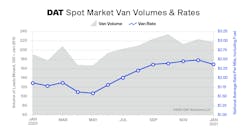Mixed results across equipment types; rates and volumes plateau
Truckload freight volumes remain high but national average spot rates fell sharply during the month of January, according to DAT Freight & Analytics.
The DAT Truckload Volume Index, a measure of dry van, refrigerated (“reefer”) and flatbed loads moved by truckload carriers, declined 2% in January from the previous month but was up 7.5% year over year.
“Spot market volumes and rates fell from record-setting levels at the end of December and our models predict a continued decline into the second quarter,” said Ken Adamo, chief of analytics at DAT. “The headwind of COVID-19 is mixing with the tailwinds of vaccine distribution and economic stimulus. There’s still uncertainty about whether consumers will continue to spend, what they’ll buy now and how networks will respond as e-commerce drives more final-mile delivery and fulfillment houses move closer to where customers live.”
Van rates hit an inflection point
The van load-to-truck ratio averaged 4.3 in January, down from 4.8 the previous month. A ratio of 4.3 means there were 4.3 available loads for every available truck on the DAT network. The van ratio was 10.4% lower in January compared to December but 95% higher than the ratio in January 2020.
January saw the arrival of the inflection point where contract rates are now consistently higher than spot rates for the first time since July.
The spot van rate averaged $2.36 per mile nationally in January, down 11 cents compared to December and 49 cents higher compared to January 2020. At $2.12 per mile, the average line-haul van rate (the total spot rate minus fuel surcharges) fell from end-of-year highs.
Reefer, flatbed rates decline but outpace 2019
Spot reefer volumes fell 3.5% m/m. The national average reefer load-to-truck ratio fell to 8.2, still five times higher than April’s record low of 1.7 loads per truck. The national average spot reefer rate was $2.61 per mile, down 7 cents compared to December and 37 cents higher year over year.
The national flatbed load-to-truck ratio averaged 47.9 in January, the highest since the summer of 2018. January flatbed volumes were up 3% compared to December and down 9.5% y/y. The national average spot flatbed rate was $2.50 per mile, 1 cent higher than December and 33 cents higher than January 2020.
DAT Freight outlook
According to DAT’s most recent Pulse Signal Report, the market is expected to follow historical trends, with contract rates lagging behind the spot market by several months and likely peaking in Q2. The major economic factors impacting freight will likely be:
- Vaccine distribution: While the majority of truckload carriers are not involved in distributing vaccines, preparation for the post-pandemic world has both demand and supply implications. Markets should slowly start to rebalance as vaccines become more widely available.
- Consumer spending: The shift in consumer spending habits to e-commerce is here to stay and a potential economic stimulus package will likely drive up consumer demand.
- Fuel prices: After labor, fuel is a trucking company’s largest operating expense. The average price of on-highway diesel increased 37 cents a gallon from the start of November to the end of January. Higher prices can increase costs and reduce per-mile revenue, especially for smaller carriers.
- Long-haul driver employment: A shortage of qualified long-haul drivers continues to constrain truckload capacity. COVID has affected carriers’ ability to recruit and train new drivers, and an increase in regional, local and last-mile logistics jobs are attracting drivers who want to work closer to home.
- Dwell and detention: Delays at loading or receiving facilities because of health screenings, a shortage of lumpers or dock workers or long lines at the gate take up potential driving time. Shippers and receivers that have the ability to measure dwell times and reduce detention will have an advantage when it comes to retaining their carriers.

